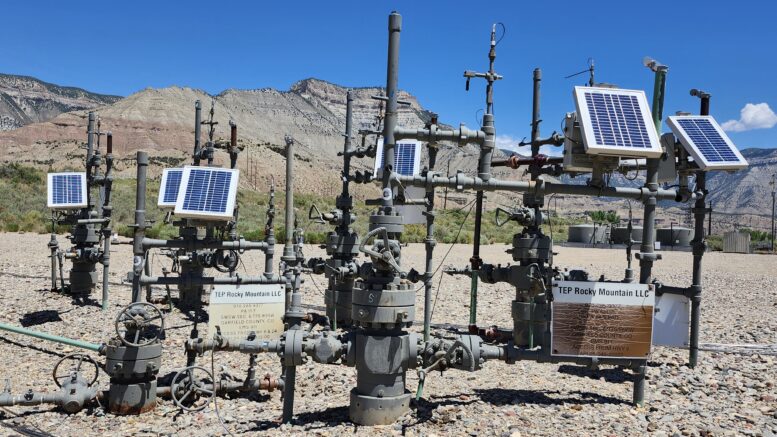Colorado regulators are debating an “enormous” set of regulations that will require consideration of the cumulative impacts of any new or expanded oil-and-gas project on air, water and other natural resources before state officials can grant operating permits.
The rules are the product of several laws passed since 2019 aiming to protect communities already dealing with significant emissions by requiring the state to consider permits in the context of existing pollution rather than focus only on the impacts of the new projects. The most recent bill on the subject, approved this year, gave the Colorado Energy and Carbon Management Commission a specific definition of “cumulative impacts” around which it must build the new regulations.
However, even with the definition — essentially, the effects on public health and environment caused by impacts of new and expanded operations when added to the impacts of other “past, present or reasonably foreseeable future development” in the area — there is major disagreement on the specifics.
A host of environmental-advocacy groups believe the state is not doing enough to protect the typically poorer and higher-minority “disproportionately impacted communities” that are closest to oil and gas producers. Many are upset about several changes that were made from a June draft to an August draft of the new regulations, particularly removal of a provision that would have required every resident within 2,000 square feet of a new permit applicant in a DIC to have to a veto over that proposal.
“This recent version caters to industry requests that yield few adequate protections for the communities that need them the most,” said Megan Kemp, director of Healthy Air and Water Colorado.
A split between regulators, environmental groups
ECMC regulators defend their proposal, saying they have added numerous protections for DICs that are not in current law, including several that were included in the August draft after not being included in the June draft. And industry leaders, rather than seeking a significant decrease in regulations, have largely backed the current proposal, asking CECMC members during a hearing that began on Sept. 3 not to revert to the former plans.
“On the whole, the trades do regard the August 2nd version of the proposed rules as an improvement … but still have concerns,” said Julie Rhine, an attorney with Brownstein Hyatt Farber Schreck who is representing the Colorado Oil & Gas Association. “The scope of these proposed rules is enormous.”

Colorado Energy and Carbon Management Commission Chairman Jeff Robbins (middle top box) speaks to CECMC members and staffers during a rulemaking hearing on Sept. 3.
ECMC members paused their hearing on Tuesday afternoon and will resume on Sept. 17, expecting deliberations could continue through the end of September. Many of the new rules are proposed to go into effect on Jan. 1.
At the heart of the plan is a new cumulative-impacts analysis that applicants must submit with permit requests including a narrative description of their operations’ effect on air quality, water quality, climate, noise, odor, wildlife and biological and soil resources. The sources of those impacts are not limited just to the new wells or pipelines themselves but access roads, utility corridors and location construction, and the impact must be measured up to a minimum one-mile radius that the ECMC could expand.
Informed consent within 2,000 feet?
In addition, operators would have to provide pre-application notices to all residents within 2,000 square feet, would have to conduct alternate-location analyses for oil and gas development plan locations and would have to prove that projects would not cause them to exceed their allowable nitrous-oxide and greenhouse-gas intensity targets. And operators who have received permits under old rules to conduct pre-production activities such as fracking during the high-ozone season of May to September would have to seek permission again under the new rules and describe enhanced services and practices that will mitigate and minimize their emissions.
The biggest sticking point for environmental groups was what was not in the final rules — a previously considered requirement that operators receive informed consent from every resident within 2,000 square feet of a well pad or not be able to proceed. Opponents of the final proposal, including a group of legislators complaining that the rule falls short of the intent of the law, also said the state should not limit the impact-study area to just one mile and should impose sector-wide limits on nitrous oxide emissions.
Sabrina Trask, manager of CECMC’s cumulative impacts and energy transition unit, noted that in lieu of the informed consent requirement for the 2,000 square-foot area in DICs, officials proposed more protections for the communities. They expanded the time in which affected communities could comment on proposals, prescribed more participation in early consultations for community members and demanded updated cumulative-impact analyses on projects approved before 2021, she noted.
Requested changes regarding cumulative impacts
Plus, the law creates two community liaisons — one slated for the Front Range and the other for the Western Slope — to make these communities aware of their ability to participate in hearings and help them to do so. And it requires cumulative-impact analyses to include a proposed number of wells to be plugged and tanks to be decommissioned.

Attorney Mark Matthews speaks at a Colorado Energy and Carbon Management Commission hearing on Sept. 9.
None of that seemed to satisfy community groups who said the state should do more to limit new projects in already polluted communities and to reduce the 53,000 active oil and gas wells in Colorado. Groups proposed expanding the notification area from 2,000 square feet to 1 square mile, creating a cumulative nitrous-oxide emissions cap (which the Colorado Air Quality Commission rejected in December) and giving the CECMC more leeway to deny permits based on the cumulative-impact analyses.
“In times like these, when commissions have the opportunity to lead humanity forward … it’s more important than ever to ensure you are doing as little as possible to cause communities harm,” said Ciara Guerrero, a Colorado Springs resident.
Industry leaders requested changes of their own, though they were comparatively minor.
Luke McCartney, facilities engineering manager for Chevron USA, said that requirements for projects in DICs to have enhanced services and practices should be delayed until 2026, as it’s too late in design for some projects to change their makeup by January. And several COGA officials pleaded with commissioners not to impose one-size-fits-all requirements on mandated upgrades — particularly mandates to electrify equipment, which can become very costly for remote facilities and require utility-service extensions that they may not be able to get.
Cumulative-impacts rules draw support
But largely the sector leaders argued that protections for DICs are adequate in the most recent rule draft and don’t need to strengthening. Dave Neslin, a Davis Graham & Stubbs attorney representing Chevron, noted that DICs were mentioned 44 times in the rules — as many times as God is mentioned in the first two chapters of the Book of Genesis.
Trisha Fanning — executive director of the Colorado OG Society, which includes small- to mid-sized oil-and-gas companies — said rules put into place in 2020 already have made it more difficult to get permits for projects. Where commissioners OK’d 1,180 well locations between January 2017 and April 2019 (when a new law increasing regulations was signed), they permitted just 149 well locations from 2021-23, she said.
“The Legislature had an opportunity to enact a ban (on new projects in DICs) but did not do so,” COGA attorney Mark Matthews said, referring to the death of more restrictive bills in a compromise earlier this year. “This is very telling.”
